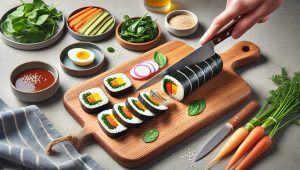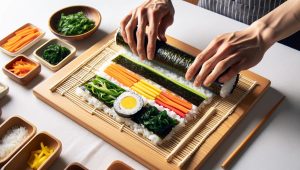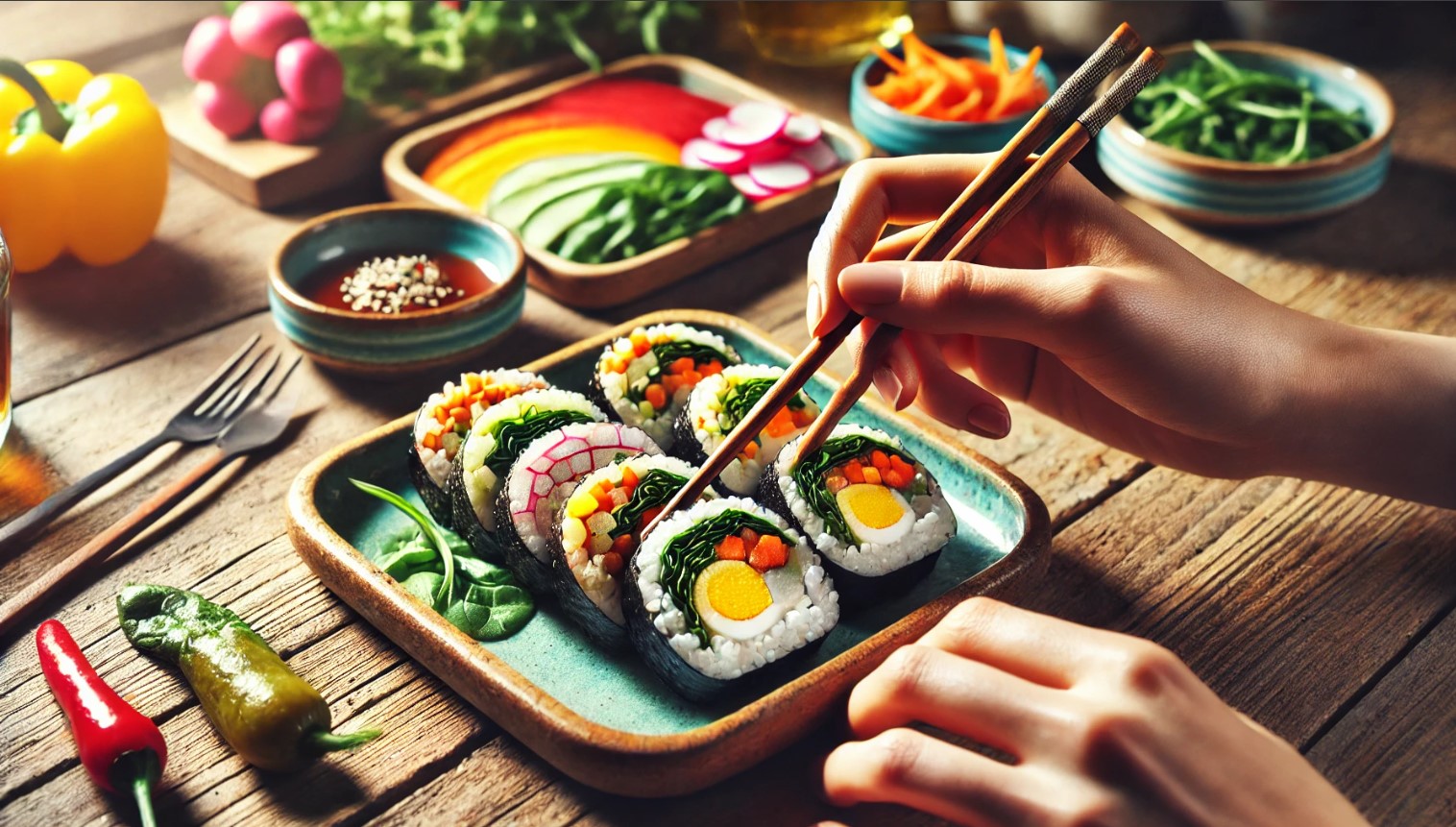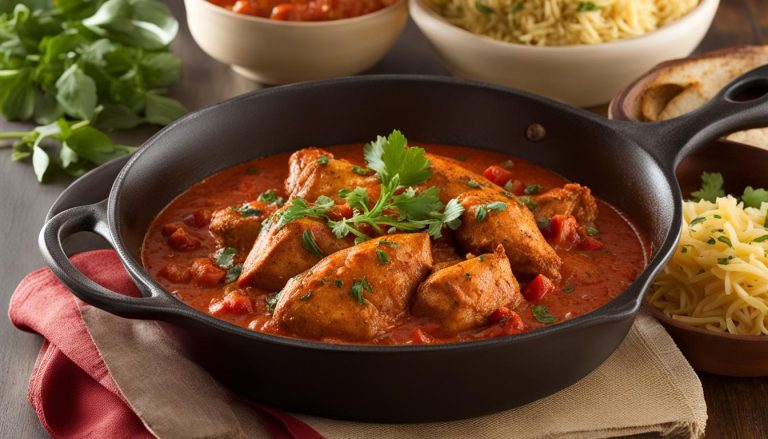There’s something magical about kimbap recipe, or gimbap recipe (김밥), that makes it a quintessential Korean dish loved by people of all ages.
Whether it’s enjoyed on a sunny afternoon picnic, packed in a child’s lunchbox, or savoured as a quick snack, kimbap is as versatile as it is delicious.
I still remember my first taste of this vibrant seaweed rice roll—it was the perfect blend of savoury, nutty, and slightly sweet flavours, all wrapped up in one neat, portable bite.
If you’ve ever wondered how to make this Korean favourite at home, I’m here to guide you step-by-step. By the end of this recipe, you’ll see why kimbap has captured the hearts (and stomachs!) of food lovers worldwide.
What is Kimbap?

Kimbap, literally translated as “seaweed rice,” is a beloved Korean dish made of cooked rice and various fillings, all wrapped in a sheet of dried seaweed (nori). It’s sliced into bite-sized pieces and is perfect for on-the-go meals.
What Makes Kimbap Recipe Unique?
Kimbap is often compared to sushi due to its rolled appearance, but the two have significant differences:
- Seasoning: Kimbap rice is flavoured with sesame oil and salt, giving it a nutty aroma, whereas sushi rice is seasoned with rice vinegar.
- Fillings: While sushi often includes raw fish, kimbap fillings are typically cooked or pickled, ranging from vegetables to meat.
- Cultural Context: Kimbap is a popular choice for picnics, school lunches, and casual meals in Korea. It’s designed for convenience and portability.
Perfect for Picnics and More
Kimbap’s compact size and versatility make it a must-have for outdoor gatherings, road trips, or quick family meals. It’s easy to customise with different fillings, making it suitable for everyone, from kids to adults with adventurous palates.
Essential Ingredients for Kimbap

Kimbap revolves around four main components: the rice, seaweed, fillings, and seasonings. Let’s explore these essentials.
Here’s a detailed ingredient table with quantities for making kimbap:
| Ingredient | Quantity |
| Short-grain white rice | 2 cups (uncooked) |
| Sesame oil | 2 tablespoons |
| Salt | 1 teaspoon |
| Seaweed sheets (nori) | 5 sheets |
| Pickled radish (danmuji) | 5 long strips |
| Carrots | 1 medium, julienned |
| Spinach | 1 cup (blanched and drained) |
| Eggs | 3 large |
| Beef bulgogi (optional) | 150 grams (cooked) |
| Soy sauce | 1 teaspoon (optional) |
| Sesame seeds | 1 teaspoon (for garnish |
Traditional Fillings: Classic fillings include pickled radish (danmuji), sautéed carrots, spinach, fried egg strips, and beef bulgogi.
Modern and Fusion Fillings: If you’re feeling experimental, try incorporating tuna mayo, kimchi, avocado, cream cheese, or smoked salmon. The possibilities are endless!
How to Make Kimbap at Home?
Making kimbap is easier than you think. Follow these simple steps to roll your own delicious creation.
Step 1: Prepare the Rice

- Use short-grain white or brown rice for the best texture.
- Cook the rice and let it cool slightly.
- Mix it with sesame oil and salt to season it and prevent it from sticking.
Step 2: Prepare the Fillings

- Carrots: Julienne the carrots and lightly sauté them with a pinch of salt.
- Spinach: Blanch fresh spinach, squeeze out excess water, and season with sesame oil.
- Egg: Beat eggs, fry into a thin omelette, and slice into strips.
- Pickled Radish: Slice into long strips.
- Meat (optional): Cook beef bulgogi or any protein of your choice.
Step 3: Assemble and Roll

- Place a sheet of seaweed, shiny side down, on a bamboo rolling mat.
- Spread a thin, even layer of rice over the seaweed, leaving about 2 cm at the top edge.
- Lay your fillings horizontally across the rice.
- Roll tightly, using the mat to guide you, and apply gentle pressure to keep the roll firm.
Step 4: Slice and Serve

- Use a sharp knife to cut the roll into 1.5 cm pieces.
- For clean cuts, wipe the knife with a damp cloth between slices.
Tips for Perfect Kimbap Every Time
Making kimbap is an art that becomes easier with practice. To achieve consistently great results, keep these tips in mind:
- Choose the Right Rice: Use short-grain white or brown rice, as it has the ideal stickiness for holding the roll together. If it’s too dry, your kimbap may crumble, while overly wet rice can make the roll soggy.
- Season the Rice Well: Properly seasoned rice is the foundation of kimbap. Mix cooked rice with sesame oil and salt while it’s warm to distribute the flavours evenly.
- Work with Fresh and Balanced Fillings: Use fresh, high-quality ingredients, and don’t overload the roll. A mix of crunchy, soft, and savoury fillings ensures a balanced texture and taste.
- Tight Rolling Technique: Roll firmly but not too tightly to avoid squishing the fillings. The bamboo mat is your best tool—use it to apply even pressure as you roll.
- Keep the Knife Clean: When slicing kimbap, a sharp knife is essential. Wipe the blade with a damp cloth between cuts to ensure clean edges and prevent the rice from sticking.
- Prevent Sogginess: Lay fillings like pickled radish or sautéed vegetables on paper towels before rolling to remove excess moisture. This step will keep your kimbap fresh and firm.
Popular Kimbap Variations
One of the joys of making kimbap is its versatility. Here are some creative variations you can try:
- Classic Kimbap: This version includes traditional fillings like pickled radish, spinach, egg, and bulgogi. It’s simple yet satisfying and showcases authentic Korean flavours.
- Vegetarian Kimbap: Packed with fresh vegetables like carrots, cucumber, spinach, and avocado, this version is perfect for plant-based diets. Add marinated tofu for extra protein.
- Spicy Tuna Kimbap: A modern twist featuring tuna mixed with mayonnaise and gochujang (Korean chilli paste). It’s creamy, spicy, and incredibly flavourful.
- Kimchi Kimbap: For those who love bold flavours, kimchi kimbap adds a spicy, tangy kick. Pair it with eggs or fried spam for a delicious fusion.
- Fusion Kimbap: Experiment with ingredients like smoked salmon, cream cheese, or even hummus for a unique twist on the classic roll.
Storing and Serving Suggestions
Proper storage and thoughtful serving can elevate your kimbap experience:
Storing Kimbap
- Wrap It Well: After slicing, tightly wrap the kimbap in cling film to preserve moisture and freshness. This prevents the rice from hardening.
- Refrigerate Promptly: If not consumed immediately, store the rolls in an airtight container in the fridge. Consume within 24 hours for the best texture and flavour.
- Avoid Freezing: Freezing kimbap can compromise the texture of the rice and seaweed, making it less appetising.
Serving Suggestions
- Dipping Sauces: While kimbap is often eaten without a dip, a mix of soy sauce, sesame oil, and a touch of vinegar can complement the flavours beautifully.
- Side Dishes: Serve kimbap with Korean side dishes (banchan) like kimchi, pickled radish, or spicy cucumber salad.
- Pair with Soups: A hot bowl of kimchi jjigae or miso soup enhances the meal and provides a comforting balance to the cold rolls.
Nutritional Benefits of Kimbap
Kimbap is not only delicious but also packed with essential nutrients. Here’s a breakdown of the nutritional profile of a standard serving (one roll, approximately 8-10 pieces):
| Ingredient | Nutritional Benefit | Calories (per serving) |
| Cooked Rice | Source of carbohydrates for energy. | 200 kcal |
| Seaweed (Nori) | Rich in iodine and minerals. | 10 kcal |
| Egg | High-quality protein and vitamins. | 70 kcal |
| Pickled Radish | Low in calories, good for digestion. | 10 kcal |
| Carrots | Vitamin A for eye health. | 15 kcal |
| Spinach | Iron and antioxidants. | 10 kcal |
| Beef Bulgogi | Protein and essential amino acids. | 120 kcal |
| Sesame Oil | Healthy fats for heart health. | 40 kcal |
Total Calories Per Roll: Approximately 475-500 kcal
Conclusion
Making kimbap at home is a rewarding experience that brings the essence of Korean cuisine to your kitchen. Its vibrant appearance, balanced flavours, and customisable nature make it a favourite for picnics, parties, or a quick weekday meal. Try your hand at this easy recipe, and enjoy the satisfaction of creating a dish that’s as fun to make as it is to eat.
FAQs
Can I use sushi rice for kimbap?
Yes, but season it with sesame oil and salt for the authentic kimbap taste.
What are some vegan kimbap filling ideas?
Try cucumber, carrot, avocado, spinach, and marinated tofu.
How do I keep kimbap fresh for longer?
Wrap it tightly in cling film and refrigerate. Consume within a day for the best taste.
What’s the secret to neatly sliced kimbap?
Use a sharp knife and clean it with a damp cloth after each cut.
Can I prepare kimbap in advance?
Yes, you can assemble it the night before. Just wrap it well to maintain freshness.
What’s a good sauce for dipping kimbap?
A mix of soy sauce, sesame oil, and a touch of vinegar works wonderfully.
Is kimbap gluten-free?
It can be, depending on the fillings and soy sauce you use. Opt for gluten-free soy sauce if needed.

Kimbap Recipe
Ingredients
- 2 cups Uncooked Short-grain White Rice
- 2 tablespoons Sesame oil
- 1 teaspoon Salt
- 5 Seaweed sheets nori
- 5 Pickled radish long strips danmuji
- 1 Julienned Carrots
- 1 cup Blanched and Drained Spinach
- 3 Large Eggs
- 150 grams Cooked Beef Bulgogi
- 1 teaspoon Soy Sauce
- 1 teaspoon Sesame Seeds
Instructions
- Use short-grain white or brown rice for the best texture.
- Cook the rice and let it cool slightly.
- Mix it with sesame oil and salt to season it and prevent it from sticking.
- Place a sheet of seaweed, shiny side down, on a bamboo rolling mat.
- Spread a thin, even layer of rice over the seaweed, leaving about 2 cm at the top edge.
- Lay your fillings horizontally across the rice.
- Roll tightly, using the mat to guide you, and apply gentle pressure to keep the roll firm.
- Use a sharp knife to cut the roll into 1.5 cm pieces.
- For clean cuts, wipe the knife with a damp cloth between slices









